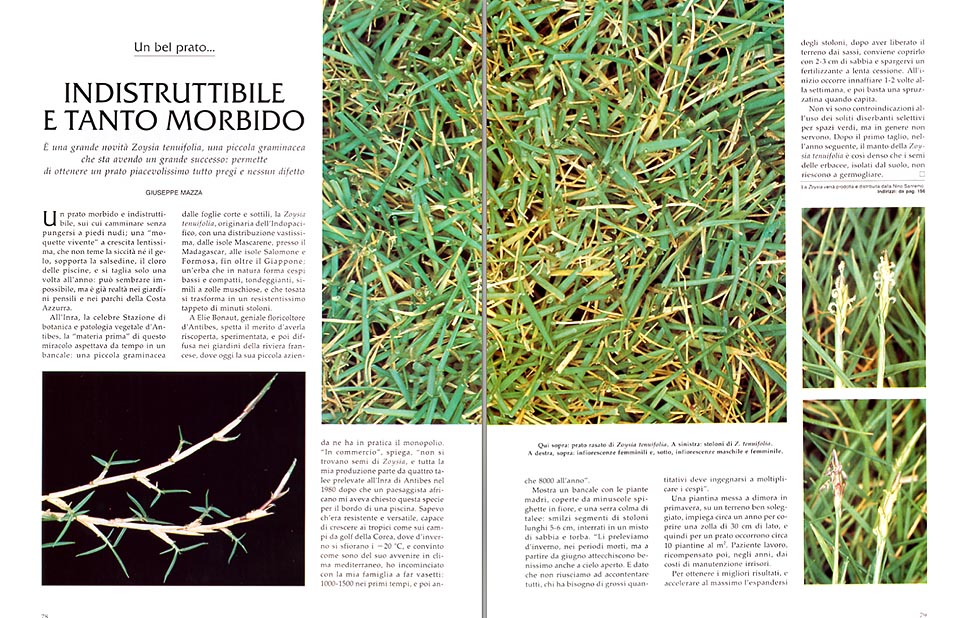A beautiful lawn. Indestructible and so soft. The novelty lawn that you never mow.


Texto © Giuseppe Mazza

English translation by Mario Beltramini
A soft and indestructible lawn, where we can walk, barefoot, without being pricked; a “living moquette”, with a very slow growth, which does not fear drought and frost, tolerates the saltiness, the chlorine of the swimming pools, and is to be mown only once a year: it may look impossible, but it is already a reality in the hanging gardens and the parks of the Côte d’Azur, where the lack of rains of the last two years, and the prohibition of “arroser les pelouses”, have sharpened the wits.
At INRA, the famous Station of Botany and Vegetable Pathology of Antibes, the “raw material” of this miracle was waiting, since some time, on a bench: a small graminea with short and thin leaves: the Zoysia tenuifolia, native to the Indo-Pacific, with a very ample distribution from the Mascarene Islands, close to Madagascar, to the Solomon Islands, and Taiwan, till Japan, and farther; a grass which, in the wild, forms low and dense bushes, roundish, similar to mossy sods, and that, once mown, transforms into a very resistant carpet of minute stolons.
Elie Bonaut, brilliant floriculturist of Antibes, has the merit of having discovered it again, experimented, and spread in the gardens of the French Riviera, where now his small firm has practically the monopoly.
In the trade, he explains me, it is not possible to find seeds of Zoysia, and all my production starts from four cuttings drawn at INRA, in 1980, after that an African landscape architect had requested me this species for the hedge of a swimming pool.
I knew that it was resistant and versatile, able to grow up either in the Tropics or in the golf-courses of Korea, where, in winter, they approach the -20 °C, and, being convinced of its future in the Mediterranean climate, I have begun, with my family, to make pots: 1.000-1.500 to start, and later, even 8.000 per year.
He shows me a bench with the mother plants, covered by tiny small spikes in flower, and a greenhouse full of cuttings: slim segments of stolons, long 5-6 cm, interred in a mixture of sand and peat.
We take them off in winter, during the dead periods, but, starting from June, they take root very well also in open air. And, as we are unable to satisfy all, those needing great quantities, have to manage to multiply the tufts.
A small plant settled in spring, in a well exposed to the sun ground, takes about one year to cove a sod of 30 cm of side, and therefore, for a lawn, are necessary about ten small plants per square metre. Long and patient work, repaid later, in the years, by the very low maintenance costs.
In order to get best results, and accelerate at the maximum the expansion of the stolons, after having freed the ground of the stones, it is convenient to cover it with 2-3 cm of sand, and spread over a slow cession fertilizer. At the beginning, it is necessary to water 1-2 times a week, and it suffices a light spray when it happens.
There are no contraindications to the use of the habitual selective pesticides for green spaces, but, usually, they are not needed. After the first cut, the following year, the mantle of the Zoysia tenuifolia is, in fact, so much thick, that the seeds of the weeds, isolated from the soil, cannot even sprout.
GARDENIA – 1991
